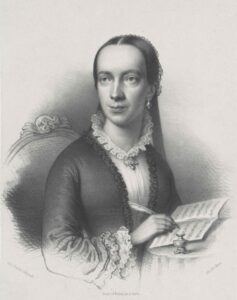
Emilie Mayer (1812-1883) was the most prolific German woman composer of the Romantic period, and performances of her music were received with great critical acclaim in Brussels, Lyons, Budapest, Dessau, Halle, Leipzig, and Munich. Mayer studied piano, counterpoint and fugue, and orchestration privately. After settling in Berlin, she organized performances of her music in her own home and in the Königliches Schauspielhaus. She traveled regularly between Vienna, Berlin, Stettin, and Pasewalk to promote the printing and performance of her works. Her accolades include the gold medal of art from Queen Elizabeth of Prussia, honorary membership in the Philharmonic Society of Munich, and she was the Associate Director of the Opera Academy in Berlin.
Most of Mayer’s music is housed in the Berlin Staatsbibliothek. Her compositions include a Singspiel, sinfonias and overtures, choral works, lieder, violin and cello sonatas, piano trios, string quartets, and solo piano works. Mayer was also a professional sculptor, and some of her pieces were housed in royal collections.
Resources
Sources
Rieger, Eva. “Mayer, Emilie.” Grove Music Online. 2001.
Works Featured on Expanding the Music Theory Canon
Humoresque III, Op. 41
Excerpt
Pages: Intervals, Passing Tone, Suspensions, 6/4 Chords
“Adagio non troppo” from Sonata in F, op. 17
Excerpt
Pages: Neighbor Tone, Suspension
Humoresque II, Op. 41
Excerpt
Page: Suspensions
Vor mein Herzlein
Excerpt
Page: Secondary Function
Tonwellen, Op. 30
Full Score
Page: Ternary